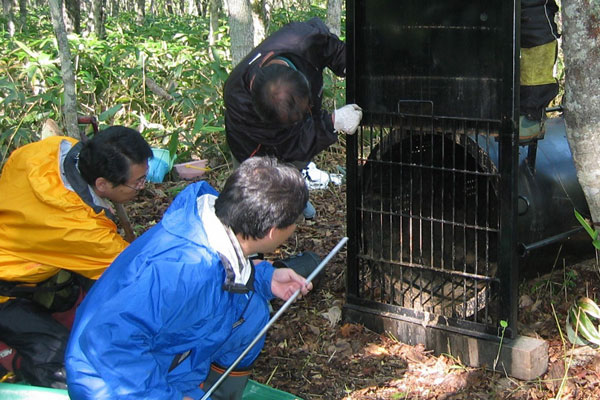
Our ultimate goal is conserving biodiversity. To contribute to the conservation and management of wild animals, we've dedicated ourselves to research and education on wildlife medicine and conservation medicine. Mainly, we've clarified the physiology and ecology of large mammals such as bears and deer, and we've tried to apply our research results to the conservation and management of wild animals. Also, we've revealed the true picture of infectious diseases transmitted by wild animals; specifically, we've clarified infection routes and modes of infection between humans, livestock and wild animals. Further, we've conducted research on the issues related to alien species, such as raccoons, with a particular focus on the harmful effects to native species and humans. We've conducted research on measures to solve the issues.
Examples of our research themes are as follows.
- The relationship between bear nutrition and reproduction
- Hibernating bears' physiology and metabolic processes
- The ecology, behavior and genetic makeup of brown bears inhabiting eastern Hokkaido
- The mode of infection for ixodid tick-mediated infectious diseases in wild animals in Hokkaido
- Control of infectious diseases and conservation of biodiversity in Nepal
- Raccoon reproduction, infectious diseases and genetic makeup
Research on bear physiology and ecology is one of our current focuses.
Bears have a unique physiological mechanism that enables them to lower their metabolism during hibernation and that enables them to be pregnant, to give birth and to nurse while fasting.
Moreover, although they are classified in the order Carnivora, they rely on plants for most of their nutrition, and they forage efficiently from food that changes from season to season and year to year. Their ecology is fascinating.
We have returned the results of our research to education on wildlife medicine and conservation medicine. We hope that our students will graduate with a great deal of knowledge about wild animals. We provide graduate students with education that allows them to improve their expertise so that they can stand on their own feet as wild animal experts. In addition to the above, we've done a range of activities for outreach to the public and to the research community.




| April 1, 1995 | The Laboratory of Ecology is established as the 17th laboratory in the Graduate School of Veterinary Medicine. Professor Noriyuki Ohtaishi heads up the lab for nine years (from the beginning to March 2004). |
|---|---|
| April 1, 2007 | Toshio Tsubota becomes the second leader of the laboratory |
| April 1, 2008 | Assistant Professor Michito Shimozuru joins the laboratory. |
| April 1, 2010 | The laboratory is renamed the Laboratory of Wildlife Biology and Medicine. |
| April 1, 2013 | Dr. Michito Shimozuru is promoted to associate professor. |
| July 16, 2013 | Dr. Mariko Sashika arrives as specially appointed assistant professor. |
The laboratory's ultimate goal is biodiversity conservation. Toward this goal, we aim to be a center of education and research that contributes to the conservation and management of wild animals. In the immediate future, the lab's main research areas are conservation biology and wildlife medicine.
Specifically, the physiology and ecology of large mammals such as bears, deer and marine animals are studied. Another important mission of the lab is to foster specialists on wild animals through education and research.